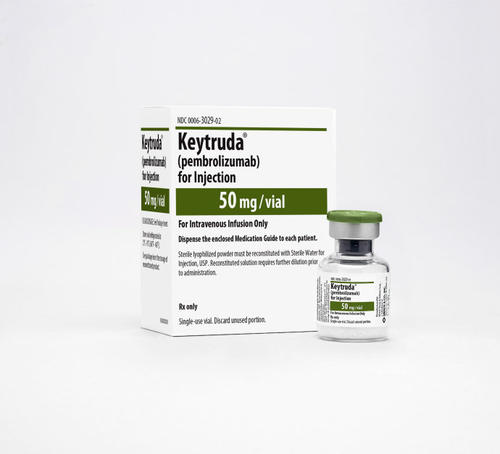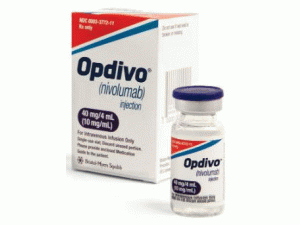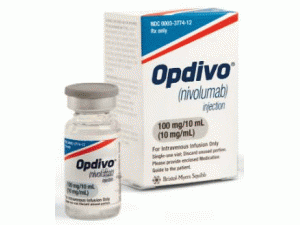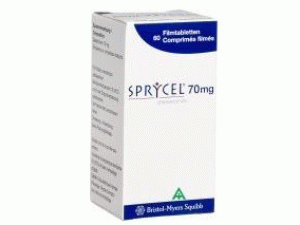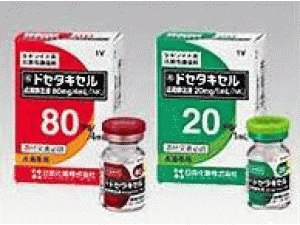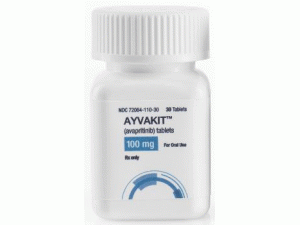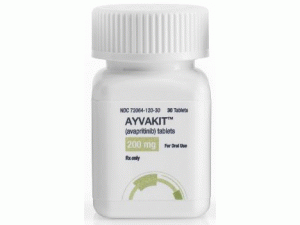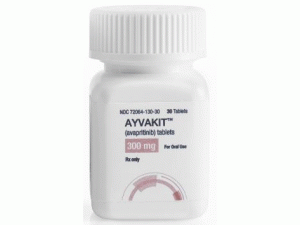厄达替尼薄膜片erdafitinib(Balversa Tablets 5mg)
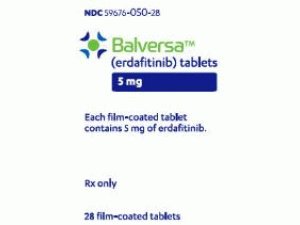 产地国家: 美国
处方药:是
所属类别: 5毫克/片 28片/盒
包装规格:5毫克/片 28片/盒
计价单位:盒
生产厂家中文参考译名:扬森制药
生产厂家英文名:Janssen Products LP
原产地英文商品名:BALVERSA 5mg/tablets 28tablets/box
原产地英文药品名:erdafitinib
中文参考商品译名:BALVERSA 5毫克/片 28片/盒
中文参考药品译名:BALVERSA 5毫克/片 28片/盒
产地国家: 美国
处方药:是
所属类别: 5毫克/片 28片/盒
包装规格:5毫克/片 28片/盒
计价单位:盒
生产厂家中文参考译名:扬森制药
生产厂家英文名:Janssen Products LP
原产地英文商品名:BALVERSA 5mg/tablets 28tablets/box
原产地英文药品名:erdafitinib
中文参考商品译名:BALVERSA 5毫克/片 28片/盒
中文参考药品译名:BALVERSA 5毫克/片 28片/盒
简介:
新型抗癌药BALVERSA(erdafitinib)片-获美国FDA加速批准用于治疗局部晚期或转移性尿路上皮癌。近日,美国食品和药物管理局今天批准加速批准Balversa(erdafitinib)片剂上市,这是一种治疗患有局部晚期或转移性膀胱癌的成人患者,其具有一种易感基因改变,称为FGFR3或FGFR2,并且在之前或之后发展含铂化疗。应使用FDA批准的伴随诊断设备选择患者进行Balversa治疗。此次获批准是第一个针对转移性膀胱癌患者的易感FGFR基因改变的个性化治疗,“FDA的肿瘤学博士,FDA肿瘤中心主任和FDA中心血液学和肿瘤学产品办公室代理主任医师Richard Pazdur说。药物评价与研究。“FGFR调节重要的生物过程,包括细胞生长和发育和组织修复过程中的分裂。该药通过靶向FGFR的遗传改变起作用。批准日期:2019年4月12日 公司:扬森制药(Janssen Products LP)BALVERSA(erdafitinib)片剂,用于口服美国最初批准:2019年 作用机制:Erdafitinib是一种激酶抑制剂,可根据体外数据结合并抑制FGFR1,FGFR2,FGFR3和FGFR4的酶活性。Erdafitinib还与RET,CSF1R,PDGFRA,PDGFRB,FLT4,KIT和VEGFR2结合。Erdafitinib抑制FGFR磷酸化和信号传导,并降低表达FGFR遗传改变的细胞系中的细胞活力,包括点突变,扩增和融合。Erdafitinib在表达FGFR的细胞系和异种移植模型中显示出抗肿瘤活性源自肿瘤类型,包括膀胱癌。 适应症:BALVERSA是一种激酶抑制剂,适用于治疗(1)患有局部晚期或转移性尿路上皮癌的成年患者。(2)易感FGFR3或FGFR2基因改变和。(3)在至少一行先前的含铂化疗期间或之后进行,包括在12天内接受新辅助的含铂铂类化疗。根据FDA批准的BALVERSA伴随诊断选择患者进行治疗。该指征基于肿瘤应答率在加速批准下被批准。持续批准该适应症可能取决于确证试验中的临床益处的验证和描述。 剂量和给药:在开始用BALVERSA治疗之前,确认肿瘤标本中存在FGFR基因改变。推荐初始剂量:每日口服8毫克,如果符合标准,每日剂量增加至9毫克。在有或没有食物的情况下吞服整个。 剂型:片剂,3mg,4mg和5mg。 禁忌症:没有。 警告和注意事项: 眼部疾病:BALVERSA可引起中枢性浆液性视网膜病变/视网膜色素上皮脱离(CSR/RPED)。在治疗的前四个月,每3个月后,以及任何时间进行视觉症状,进行月度眼科检查。当CSR/RPED发生时,扣留BALVERSA,如果在4周内没有解决,或者严重程度为4级,则永久停止。 高磷血症:磷酸盐水平的增加是BALVERSA的药效学作用。监测高磷血症,并在需要时进行剂量调整。 胚胎-胎儿毒性:可导致胎儿伤害。告知患者胎儿的潜在风险并使用有效的避孕措施。 不良反应:最常见的不良反应包括实验室异常(≥20%)磷酸盐增加,口腔炎,疲劳,肌酐升高,腹泻,口干,甲剥离,丙氨酸氨基转移酶增加,碱性磷酸酶增加,钠减少,食欲下降,白蛋白减少,味觉障碍,血红蛋白下降,干性皮肤,天冬氨酸氨基转移酶增加,镁减少,干眼症,脱发,手掌动脉麻痹综合征,便秘,磷酸盐减少,腹痛,钙增加,恶心和肌肉骨骼疼痛。 药物相互作用: 强CYP2C9或CYP3A4抑制剂:密切注意替代药物或监测不良反应。 强CYP2C9或CYP3A4诱导剂:避免同时使用BALVERSA。 中度CYP2C9或CYP3A4诱导剂:将BALVERSA剂量增加至9mg。 血清磷酸盐水平改变剂:避免同时使用可在初始剂量调整期之前改变血清磷酸盐水平的剂量。 CYP3A4底物:避免同时使用敏感的CYP3A4底物,治疗指数较窄。 OCT2底物:考虑替代药物或考虑基于耐受性减少OCT2底物的剂量。 P-gp底物:在施用具有窄治疗指导的P-gp底物之前或之后,将BALVERSA施用分开至少6小时。 用于特定人群:哺乳期,建议不要母乳喂养。 存储:存放于20°C-25°C(68°F-77°F);允许的偏差在15°C至30°C(59°F至86°F)之间英文版说明书:
BALVERSA(erdafitinib)NDICATIONBALVERSA(erdafitinib)is a kinase inhibitor indicated for the treatment of adult patients with locally advanced or metastatic urothelial carcinoma that hassusceptible fibroblast growth receptor(FGFR)3 or FGFR2 genetic alterations andprogressed during or following at least one line of prior platinum-containing chemotherapy, including within 12 months of neoadjuvant or adjuvant platinum-containing chemotherapy.Select patients for therapy based on an FDA-approved companion diagnostic for BALVERSA™.IMPORTANT SAFETY INFORMATIONOcular Disorders—BALVERSA™ can cause ocular disorders, including central serous retinopathy/retinal pigment epithelial detachment(CSR/RPED) resulting in visual field defect.CSR/RPED was reported in 25% of patients treated with BALVERSA™, with a median time to first onset of 50 days. Grade 3 CSR/RPED, involving central field of vision, was reported in 3% of patients. CSR/RPED resolved in 13% of patients and was ongoing in 13% of patients at the study cutoff. CSR/RPED led to dose interruptions and reductions in 9% and 14% of patients, respectively, and 3% of patients discontinued BALVERSA™. Dry eye symptoms occurred in 28% of patients during treatment with BALVERSA™ and were Grade 3 in 6% of patients. All patients should receive dry eye prophylaxis with ocular demulcents as needed.Perform monthly ophthalmological examinations during the first 4 months of treatment and every 3 months afterwards, and urgently at any time for visual symptoms. Ophthalmological examination should include assessment of visual acuity, slit lamp examination, fundoscopy, and optical coherence tomography. Withhold BALVERSA™ when CSR occurs and permanently discontinue if it does not resolve within 4 weeks or if Grade 4 in severity. For ocular adverse reactions, follow the dose modification guidelines [see Dosage and Administration].Hyperphosphatemia–Increases in phosphate levels are a pharmacodynamic effect of BALVERSA[see Pharmacodynamics].Hyperphosphatemia was reported as adverse reaction in 76% of patients treated with BALVERSA™. The median onset time for any grade event of hyperphosphatemia was 20 days(range: 8–116) after initiating BALVERSA™. Thirty-two percent of patients received phosphate binders during treatment with BALVERSA™. Monitor for hyperphosphatemia and follow the dose modification guidelines when required [see Dosage and Administration].Embryo-fetal Toxicity – Based on the mechanism of action and findings in animal reproduction studies, BALVERSA™ can cause fetal harm when administered to a pregnant woman. In a rat embryo-fetal toxicity study, erdafitinib was embryotoxic and teratogenic at exposures less than the human exposures at all doses studied. Advise pregnant women of the potential risk to the fetus. Advise female patients of reproductive potential to use effective contraception prior to and during treatment, and for one month after the last dose. Advise male patients with female partners of reproductive potential to use effective contraception during treatment with BALVERSA™ and for one month after the last dose[see Use in Specific Populations and Clinical Pharmacology].Most common adverse reactions including laboratory abnormalities ≥20% were: Phosphate increased (76%), stomatitis (56%), fatigue (54%), creatinine increased (52%), diarrhea (47%), dry mouth (45%), onycholysis (41%), alanine aminotransferase increased (41%), alkaline phosphatase increased (41%), sodium decreased (40%), decreased appetite (38%), albumin decreased (37%), dysgeusia (37%), hemoglobin decreased (35%), dry skin (34%), aspartate aminotransferase increased (30%), magnesium decreased (30%), dry eye (28%), alopecia (26%), palmar-plantar erythrodysesthesia syndrome (26%), constipation (28%), phosphate decreased (24%), abdominal pain (23%), calcium increased (22%), nausea (21%), and musculoskeletal pain (20%). The most common Grade 3 or greater adverse reactions (>1%) were stomatitis (9%), nail dystrophy*, palmar-plantar erythrodysesthesia syndrome (6%), paronychia (3%), nail disorder*, keratitis†, onycholysis* (10%), and hyperphosphatemia.Included within onycholysis. †Included within dry eye.An adverse reaction with a fatal outcome in 1% of patients was acute myocardial infarction.Serious adverse reactions occurred in 41% of patients, including eye disorders (10%).Permanent discontinuation due to an adverse reaction occurred in 13% of patients. The most frequent reasons for permanent discontinuation included eye disorders (6%).Dosage interruptions occurred in 68% of patients. The most frequent adverse reactions requiring dosage interruption included hyperphosphatemia (24%), stomatitis (17%), eye disorders (17%), and palmar-plantar erythrodysesthesia syndrome (8%).Dose reductions occurred in 53% of patients. The most frequent adverse reactions for dose reductions included eye disorders (23%), stomatitis (15%), hyperphosphatemia (7%), palmar-plantar erythrodysesthesia syndrome (7%), paronychia (7%), and nail dystrophy (6%).DRUG INTERACTIONSStrong CYP2C9 or CYP3A4 Inhibitors: Consider alternative agents or monitor closely for adverse reactions.Strong CYP2C9 or CYP3A4 inducers: Avoid concomitant use with BALVERSA™.Moderate CYP2C9 or CYP3A4 inducers: Increase BALVERSA™ dose up to 9 mg.Serum phosphate level-altering agents: Avoid concomitant use with agents that can alter serum phosphate levels before the initial dose modification period.CYP3A4 substrates: Avoid concomitant use with sensitive CYP3A4 substrates with narrow therapeutic indices.OCT2 substrates: Consider alternative agents or consider reducing the dose of OCT2 substrates based on tolerability.P-gp substrates: Separate BALVERSA™ administration by at least 6 hours before or after administration of P-gp substrates with narrow therapeutic indices.用药温馨提示:当您服用此药物时,需定期接受医疗专业人士的检查,以便随时针对其药效、副作用等情况进行监测。本网站所包含的信息旨在为患者提供帮助,不能代替医学建议和治疗。
药品价格查询,专业药品查询网站,药品说明书查询,药品比价 » 厄达替尼薄膜片erdafitinib(Balversa Tablets 5mg)
药品价格查询,专业药品查询网站,药品说明书查询,药品比价 » 厄达替尼薄膜片erdafitinib(Balversa Tablets 5mg)

